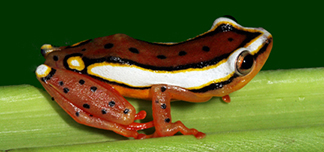| Publication Type: | Journal Article |
| Year of Publication: | 1995 |
| Authors: | G. Van Der Horst, Wilson, B., Channing, A. |
| Journal: | Memoires du Museum National d’Histoire Naturelle |
| Volume: | 166 |
| Pagination: | 333-342 |
| Date Published: | 1995 |
| Abstract: | Sperm characteristics such as the structure and position of the acrosome, the design and ultrastructure of the flagellum, the presence/absence of a neck-piece and several other fine structural details are important diagnostic features which distinguish the three orders, families and species of lissamphibians. These sperm features are also important in phylogenetic inferences. It appears that the axoneme-undulating membrane-axial rod represents a plesiomorphic character. This pattern has been simplified to a single axoneme as a secondary reversal for external fertilization in many anurans or has developed as a double axoneme as in Chiromantis xerampelina. Sperm head and acrosome length are predictive in distinguishing between terrestrial and aquatic anuran fertilizers. Sperm motility is species specific among representatives of seven of the nine South African families and motile sperm which exhibit forward progression are the rule for aquatic fertilizing anurans. In contrast, the sperm of terrestrial fertilizing anurans are immotile in a wide range of physiological/culture media with osmotic concentrations varying from 10 to 300 mOsm/kg. The term ect-terrasperm is suggested as a new terminology for amphibians which exhibit the terrestrial mode of fertilization. |
| URL: | <Go to ISI>://PREV199698744907 |
